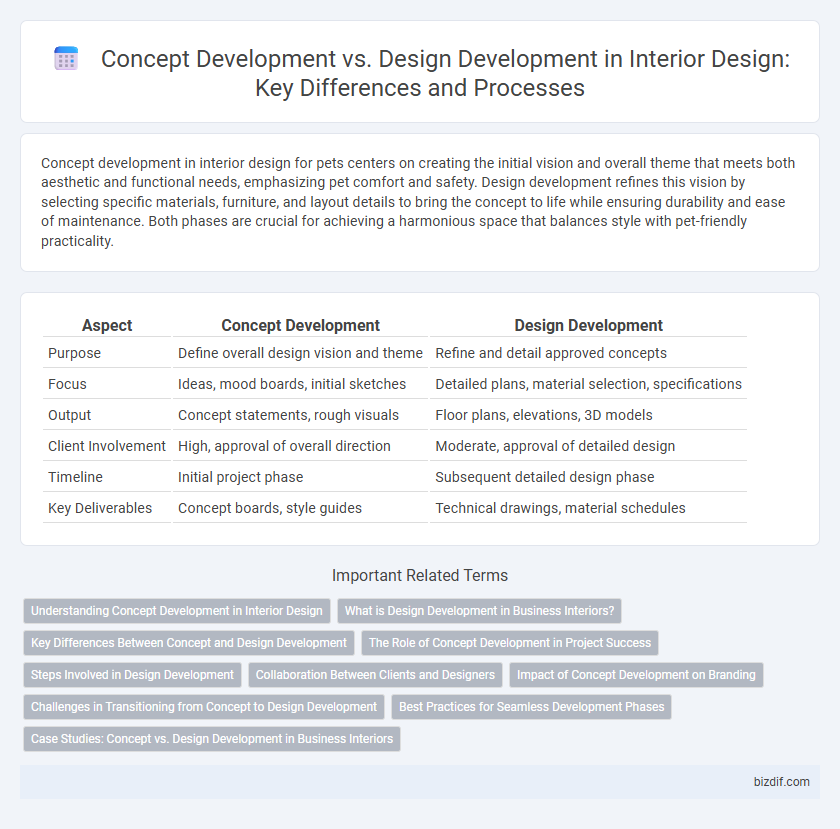Concept development in interior design for pets centers on creating the initial vision and overall theme that meets both aesthetic and functional needs, emphasizing pet comfort and safety. Design development refines this vision by selecting specific materials, furniture, and layout details to bring the concept to life while ensuring durability and ease of maintenance. Both phases are crucial for achieving a harmonious space that balances style with pet-friendly practicality.
Table of Comparison
| Aspect | Concept Development | Design Development |
|---|---|---|
| Purpose | Define overall design vision and theme | Refine and detail approved concepts |
| Focus | Ideas, mood boards, initial sketches | Detailed plans, material selection, specifications |
| Output | Concept statements, rough visuals | Floor plans, elevations, 3D models |
| Client Involvement | High, approval of overall direction | Moderate, approval of detailed design |
| Timeline | Initial project phase | Subsequent detailed design phase |
| Key Deliverables | Concept boards, style guides | Technical drawings, material schedules |
Understanding Concept Development in Interior Design
Concept development in interior design involves generating and refining the fundamental ideas that define the aesthetic, mood, and functional goals of a space, establishing a clear vision that guides all subsequent decisions. This phase focuses on understanding client needs, spatial requirements, and thematic inspirations to create a cohesive and innovative design narrative. Effective concept development lays the foundation for design development by transforming abstract ideas into actionable plans that address style, color schemes, materials, and spatial relationships.
What is Design Development in Business Interiors?
Design development in business interiors involves refining initial concepts into detailed plans that address spatial functionality, material selection, and compliance with building codes. This phase transforms abstract ideas into practical solutions by integrating client needs, ergonomic standards, and aesthetic goals to create cohesive, efficient work environments. Emphasizing precision in layouts, lighting, and furnishings ensures that the final design supports productivity and brand identity in commercial spaces.
Key Differences Between Concept and Design Development
Concept development focuses on generating initial ideas and defining the overall vision, including themes, styles, and spatial organization. Design development refines these concepts into detailed plans, specifying materials, furniture, lighting, and construction methods for implementation. The key difference lies in concept development establishing creative direction, while design development transforms ideas into precise, actionable designs.
The Role of Concept Development in Project Success
Concept development establishes the foundational vision and key themes that guide all design decisions, ensuring alignment with client goals and spatial functionality. This phase identifies user needs, site context, and aesthetic direction, which results in a coherent framework for subsequent design development stages. Effective concept development minimizes costly revisions by clarifying project scope and setting clear objectives, directly contributing to overall project success.
Steps Involved in Design Development
Design development refines initial concepts into detailed plans through steps including schematic design, material selection, and creating technical drawings. This phase focuses on spatial planning, furniture layout, lighting design, and specifying finishes to ensure functionality and aesthetics. The process culminates in comprehensive documentation that guides construction and procurement, bridging the gap between concept and execution.
Collaboration Between Clients and Designers
Concept development establishes the project's initial vision, goals, and style preferences through collaborative brainstorming sessions between clients and designers. Design development refines these ideas into detailed plans, materials, and spatial layouts, ensuring alignment with client needs and budget constraints. Effective communication and iterative feedback loops foster a strong partnership, resulting in a cohesive and personalized interior design solution.
Impact of Concept Development on Branding
Concept development establishes the foundational vision and thematic direction that shapes a brand's identity within interior design, ensuring a cohesive and memorable spatial experience. This phase influences key branding elements by integrating core values, target audience preferences, and emotional resonance into design concepts. Strong concept development enhances brand recognition and differentiation, setting the stage for successful design development and execution.
Challenges in Transitioning from Concept to Design Development
Transitioning from concept development to design development in interior design often faces challenges such as translating abstract ideas into detailed plans while maintaining original vision and client expectations. Designers must address technical constraints, budget limitations, and material selections that were not fully defined during concept stages. Effective communication and iterative revisions are essential for resolving conflicts and refining the design for practical implementation.
Best Practices for Seamless Development Phases
Concept development establishes the foundational vision by identifying client needs, spatial organization, and mood boards, ensuring alignment with project goals. Design development refines details such as materials, lighting, furniture selection, and technical drawings to create comprehensive execution plans. Best practices include continuous client collaboration, iterative reviews, and integration of feedback to maintain consistency and prevent costly revisions during later phases.
Case Studies: Concept vs. Design Development in Business Interiors
Case studies in business interiors highlight distinct stages between concept development and design development, where concept development establishes the foundational vision, spatial layout, and thematic direction to align with brand identity. Design development refines these ideas into detailed plans, specifying materials, furnishings, lighting, and technical elements that enhance functionality and aesthetics tailored for workplace efficiency. Successful projects demonstrate how a clear differentiation between these phases ensures cohesive, innovative environments that boost employee productivity and client engagement.
Concept development vs Design development Infographic

 bizdif.com
bizdif.com